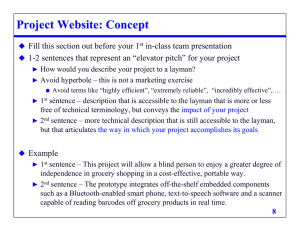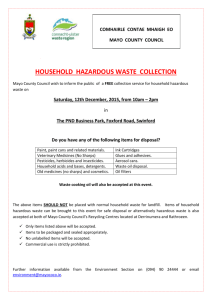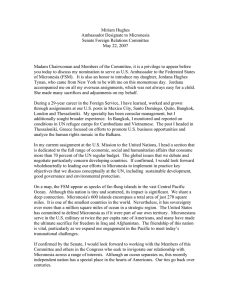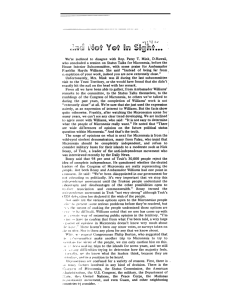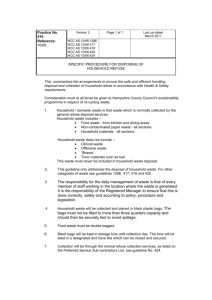Environmental Problems - College of Micronesia
advertisement
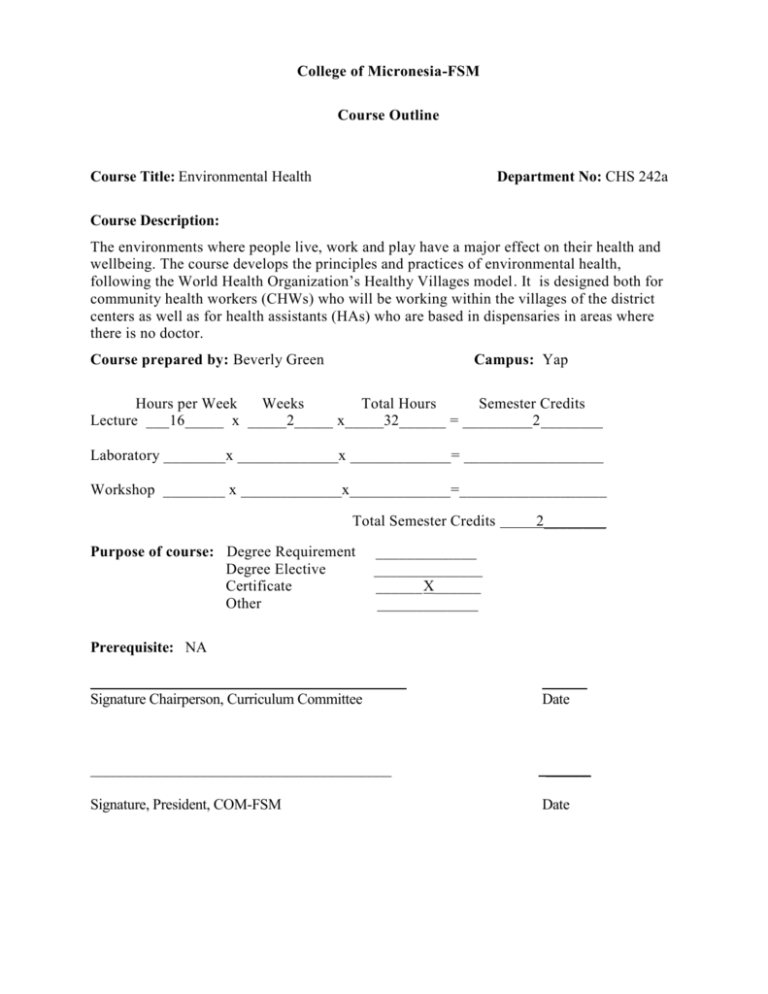
College of Micronesia-FSM Course Outline Course Title: Environmental Health Department No: CHS 242a Course Description: The environments where people live, work and play have a major effect on their health and wellbeing. The course develops the principles and practices of environmental health, following the World Health Organization’s Healthy Villages model. It is designed both for community health workers (CHWs) who will be working within the villages of the district centers as well as for health assistants (HAs) who are based in dispensaries in areas where there is no doctor. Course prepared by: Beverly Green Campus: Yap Hours per Week Weeks Total Hours Semester Credits Lecture ___16_____ x _____2_____ x_____32______ = _________2________ Laboratory ________x _____________x _____________= __________________ Workshop ________ x _____________x_____________=___________________ Total Semester Credits Purpose of course: Degree Requirement Degree Elective Certificate Other 2________ _____________ ______________ ______X______ _____________ Prerequisite: NA Signature Chairperson, Curriculum Committee Date ________________________________________ ______ Signature, President, COM-FSM Date General Course Objectives: To equip students to identify environmental health risks in the village setting and to assist people to decrease these risks. Specific Learning Objectives: - - Know the 10 principles for health workers in the Code of Conduct of the International Red Cross (see Community Health. Wood, CH. AMREF, 2nd ed. Nairobi Kenya, 1997.) Define confidentiality and explain why it is important for all health workers to preserve confidentiality. Demonstrate 3 techniques for establishing rapport with a client. Identify specific diseases and patterns of disease at the community level that may be related to environmental factors. Recognize environmental factors contributing to water-borne disease. Identify diseases prevalent in Micronesia that are water-borne, water-washed and water related. Recognize the symptoms of water-borne, water-washed and water related diseases. Explain the differing standards for water quality based on the various uses of water. Know the methods of water purification. Identify possible health risks of improper drainage of wastewater. Identify diseases prevalent in Micronesia that are vector-related. Identify diseases prevalent in Micronesia that are related to problems of human waste disposal. Learn the benefits and drawbacks of the following methods of excreta disposal: pit latrine, composting toilet, aqua-privy, cartage, burial, septic tanks, small sewage systems. Explain (to a layman) how the ventilated improved pit latrine (VIP latrine) works to control odors and flies. Describe aspects of the VIP latrine that must be in place for the unit to function correctly. Identify household sites that are and are not adequate for location of pit privies. Identify household sites that are and are not adequate for the location of septic tanks/drainage fields. Explain to the head of a household why the site of their pit privy or septic tank/drainage field is or is not adequate. Identify sites that are and are not adequate for keeping pigs. Explain (to a layman) how pigs can be involved in the spread of disease and how risks can be minimized. Explain (to a layman) how dogs can be involved in the spread of disease and how risks can be minimized. Explain (to a layman) how rats can be involved in the spread of disease and how risks can be minimized. Explain (to a layman) how flies can be involved in the spread of disease and how risks can be minimized. Describe the environmental health effects of wastewater reuse and disposal. Describe the effects of inadequate solid waste disposal on human health. Identify the different components of household solid waste and determine potential uses and/or disposal methods for each type. - - Describe the types of toxic waste present in Micronesia, identify the potential health hazards associated with the wastes, and learn alternative methods of disposal. Learn proper citing, construction, and maintenance of community refuse pits. Identify the symptoms of food-borne diseases. Define the standards of proper food safety, in preparation and in serving, both in the household and in commercial establishments such as stores and restaurants. Identify diseases prevalent in Micronesia that are air quality related. Use an environmental survey tool to inspect households and businesses. Report the results of household/business surveys to the occupants and explain the importance of findings and the ways they can be corrected. Perform an environmental intervention to prevent further spread of an identified case of dengue fever. Perform an environmental intervention to prevent further spread of an identified case of leptospirosis. Persuade people from an endemic area to take their annual dose of medicine in a filariasis eradication program. Identify Aedes and Culex mosquitoes by inspection. Explain (to a layman) the habits of Aedes mosquitoes, which diseases prevalent in Micronesia are spread by them (e.g. dengue fever), and specific measures that can be applied to prevent the spread of disease by Aedes mosquitoes. Explain (to a layman) the habits of Culex mosquitoes, which diseases prevalent in Micronesia are spread by them (e.g. filariasis, Japanese encephalitis), and specific measures that can be applied to prevent the spread of disease by Culex mosquitoes. Construct and test the effectiveness of a soda-bottle fly trap. Explain how to use clinic data to identify environmental health risk factors present in the community. Describe ways to promote hygiene and good environmental health practices within the community. Know how to quickly assess environmental health risks related to storm damage. Understand first measures to take to minimize environmental health related disease when natural disaster strikes. Course Contents: - Water and Disease. - Sanitation and Disease. - Solid Waste and Disease. - Food Safety and Environmental Hygiene. - Air Quality and Disease. - Disease Vectors. - The Community Health Survey and Prevention of disease. - Environmental health responses to an outbreak of disease. - Environmental health responses to natural disasters. Textbooks: A Guide to Health Promotion Through Water and Sanitation. Nyamwaya, David, African Medical and Research Foundation; Nairobi; 1994. [ISBN: 9966-874-53-4] Healthy Villages- A Guide for Communities and Community Health Workers. Howard, Guy; World Health Organization; Geneva; 2002 [ISBN: 92-4-154553-4] Required Course Materials: Chalkboard, LED projector with laptop, household environmental survey forms, magnifying glass and mosquito specimens for identification Methods of Instruction: Lecture, class and individual assignments, individual presentation, group discussion and research Evaluation: Examinations. Successful performance of skills components based on skills checklists. (see attached) Assessment of student counseling skills by testing comprehension of lay people who have been counseled about a topic by student. Attendance Policy: Per standard COM-FSM Policy as stated in the current catalog. Instructor to advise students of this policy on the first day of class. Academic Honesty Policy: Per standard COM-FSM Policy as stated in the current catalog.
